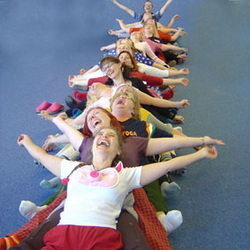Therapy
Humor Therapy

Humor Therapy throughout History
14th Century: Henri de Mondeville, a French surgeon, helped aid recovery from surgeries by using humor therapy. "Let the surgeon take care to regulate the whole regimen of the patient's life for joy and happiness, allowing his relatives and special friends to cheer him and by having someone tell him jokes," he wrote.
15th Century: An English parson and scholar named Robert Burton used humor to cure melancholy feelings.
16th Century: As part of his pastoral counseling from depressed people, Martin Luther used a type of humor therapy. He told the people to surround themselves with friends that were capable of joking around with them and making them laugh.
17th Century: Herbert Spencer, a sociologist, used humor in order to release excess tension.
18th Century: A German philosopher named Immanuel Grant used humour to restore equilibrium.
18th Century: William Battie, an English physician, used humour in order to treat the ill.
20th Century: Modern humour therapy dates back to the 1930s, when clowns were brought into U.S. hospitals to cheer up children suffering with polio.
20th Century - 1972: Founded by U.S. Doctor Hunter 'Patch' Adams, The Gesundheit Institute is a home-based hospital free of charge that 'brings fun, friendship, and the joy of service back into health care.'
20th Century - 1979: The book 'Anatomy of an Illness,' written by and based on the experiences of Norman Cousins explains his suffering from the ankylosing spondylitis. He decided to use his own 'humor therapy' by watching 'Candid Camera' and Marx Brothers films to keep him laughing. "Ten minutes of laughter could give him two hours of pain relief."
20th Century - 1998: Thanks to the film 'Patch Adams' staring Robin Williams, humor therapy had a renewed interest during this time.
15th Century: An English parson and scholar named Robert Burton used humor to cure melancholy feelings.
16th Century: As part of his pastoral counseling from depressed people, Martin Luther used a type of humor therapy. He told the people to surround themselves with friends that were capable of joking around with them and making them laugh.
17th Century: Herbert Spencer, a sociologist, used humor in order to release excess tension.
18th Century: A German philosopher named Immanuel Grant used humour to restore equilibrium.
18th Century: William Battie, an English physician, used humour in order to treat the ill.
20th Century: Modern humour therapy dates back to the 1930s, when clowns were brought into U.S. hospitals to cheer up children suffering with polio.
20th Century - 1972: Founded by U.S. Doctor Hunter 'Patch' Adams, The Gesundheit Institute is a home-based hospital free of charge that 'brings fun, friendship, and the joy of service back into health care.'
20th Century - 1979: The book 'Anatomy of an Illness,' written by and based on the experiences of Norman Cousins explains his suffering from the ankylosing spondylitis. He decided to use his own 'humor therapy' by watching 'Candid Camera' and Marx Brothers films to keep him laughing. "Ten minutes of laughter could give him two hours of pain relief."
20th Century - 1998: Thanks to the film 'Patch Adams' staring Robin Williams, humor therapy had a renewed interest during this time.
Laughter Club

Laughter Clubs provide a rich social network of people who care about one another, and perhaps even more importantly, a way of getting to know new people who we care about. This provides a sense of emotional security which resists stress and promotes excellence in all other areas of life.
Laughter Yoga

Sources:
http://serendip.brynmawr.edu/biology/b103/f02/web2/mscottweathers.html
http://www.cancer.org/Treatment/TreatmentsandSideEffects/ComplementaryandAlternativeMedicine/MindBodyandSpirit/humor-therapy
http://www.holisticonline.com/humor_therapy/humor_therapy.htm
http://health.msn.com/health-topics/humor-therapy
http://laughtertherapy.webs.com/humourtherapy.htm
http://humortherapy.blogspot.com/2007/05/history-of-humor-therapy.html
http://www.laughteryoga.org/index.php?option=com_content&view=article&id=731:laughter-yoga-as-laughter-therapy&catid=263:laughter-yoga-for-healing-therapeutic-benefits&Itemid=457
http://www.laughteryogaamerica.com/learn/physiology-psychology-of-laughter-yoga-1527.php
http://www.joeyguse.com/2007/07/laughter-clubs.html
http://www.laughteryoga.org/index.php?option=com_content&view=article&id=460:history-of-laughter-yoga&catid=85:about-laughter-yoga&Itemid=265
http://www.cancer.org/Treatment/TreatmentsandSideEffects/ComplementaryandAlternativeMedicine/MindBodyandSpirit/humor-therapy
http://www.holisticonline.com/humor_therapy/humor_therapy.htm
http://health.msn.com/health-topics/humor-therapy
http://laughtertherapy.webs.com/humourtherapy.htm
http://humortherapy.blogspot.com/2007/05/history-of-humor-therapy.html
http://www.laughteryoga.org/index.php?option=com_content&view=article&id=731:laughter-yoga-as-laughter-therapy&catid=263:laughter-yoga-for-healing-therapeutic-benefits&Itemid=457
http://www.laughteryogaamerica.com/learn/physiology-psychology-of-laughter-yoga-1527.php
http://www.joeyguse.com/2007/07/laughter-clubs.html
http://www.laughteryoga.org/index.php?option=com_content&view=article&id=460:history-of-laughter-yoga&catid=85:about-laughter-yoga&Itemid=265
